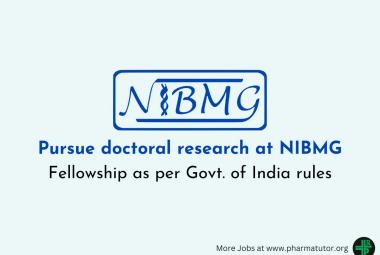{ DOWNLOAD AS PDF }
 ABOUT AUTHORS:
ABOUT AUTHORS:
R.Meera1*, N.Swathylakshmi2, M.Sundarapandian2, P.Raja Soundara Pandian1, Madhavanmallayasamy1
1Researcher, Radianz Health Care Pvt Ltd, Madurai, Tamilnadu, India
2Department of pharmaceutical Chemistry, K.M.College of pharmacy, Uthangudi, Madurai, India
meeraharsa23@gmail.com
ABSTRACT
Objective: A simple and precise RP-HPLC method was developed and validated for the determination of Nitaoxanide in pharmaceutical dosage forms.
Materials and Methods: Chromatography was carried out using waters RP –C18 150×4.6 mm, 3.5 µ, pH 6.8, buffer: acetonitrile (50:50) as the mobile phase at a flow rate 1.2 ml/min. The analyze was monitored using PDA detector at 254 nm. The proposed method was found to have linearity in the concentration range of 25-150µg/ml with correlation co efficient of r2 =0.9999.
Results:The developed method has been statistically validated and found simple and accurate. The mean recoveries obtained for Nitaoxanide were in the range 100.06-101.9%.
Conclusion:Due to its simplicity, rapidness, high precision and accuracy of the proposed method it may be used for determining Nitaoxanide in bulk and dosage forms.
[adsense:336x280:8701650588]
REFERENCE ID: PHARMATUTOR-ART-2283
|
PharmaTutor (ISSN: 2347 - 7881) Volume 2, Issue 12 How to cite this article: R Meera, N Swathylakshmi, MS Pandian, PRS Pandian, M Mallayasamy; RP-HPLC Method for the Estimation of Nitaoxanide in Pharmaceutical Formulation; PharmaTutor; 2014; 2(12); 145-149 |
INTRODUCTION
Nitaoxanide is a synthetic nitro thiazolyl- salicylamide derivative approved for the treatment of infectious diarrhea [1] caused by Cryptosporidium parvum and Giardia lamblia. This novel agent has a broad spectrum of activity against many other gastrointestinal pathogens, including bacteria, round worms, flat worms and flukes. Nitaoxanide is used in many areas of the world, especially in Central and South America, as broad-spectrum parasiticidal agents in adults and children. In oral administration it is rapidly hydrolyzed to its active metabolite, Nitaoxanide, which is observed 1-4 hours after administration. It is excreted in the urine, bile and faeces. Chemically known as 2-[(5-nitro-1, 3-thiazol-2-yl) carbamoyl] phenyl acetate. A number of methods such as spectrophotometric [2-8], colorimetric [9,10] HPLC [11-13], HPTLC [14], RP HPLC [15-18] for the estimation of Nitaoxanide. The present communication describes 3 UV spectroscopic methods in bulk form and dosage form by using different reagent 4-hydroxy benzaldyhyde and phluroglucinol having maximum absorbance at 460 and 450 nm.
Experimental
Instruments
High performance liquid chromatography (Shimadzu HPLC, Model: SPD M20 A) prominence with high pressure gradient system with photo diode array detector was used.
Chemicals and reagents
Nitaoxanide was obtained as a gift sample from Lupin pharmaceuticals Pondicherry (sample), Water (HPLC grade), acetonitrile (HPLC grade) and methanol (HPLC grade) were used.
[adsense:468x15:2204050025]
Chromatographic conditions
A chromatographic system (Shimadzu, Japan) consisting of a solvent delivery pump, a degasser, an injector, an RP column, UV detector. An ODS (octadecylsilane) packed C18 column was used for separation. The instrumental settings were at the flow rate of 1.2ml/mt. The injection volume was 20µl. The peak purity was checked with the UV detector (SPD 20A). Detection was performed at 254nm. Software used is Spin chrome.
Selection of wavelength
From the UV spectrum of the compound, the λmax of Nitaoxanide was found to be 254nm and that wavelength is suitable for detection. So the appreciable absorbance was found at 254nm Table no 1.
TABLE NO 1
|
|
PARAMETERS |
VALUES |
|
1 |
Wavelength |
254nm |
|
2 |
Flow rate |
1.2ml/mt |
|
3 |
Column |
C18 |
|
4 |
Injection volume |
20 µl |
Preparation of Mobile phase
The mobile phase consisted of di potassium hydrogen phosphate buffer and acetonitrile in the ratio (70:30). The mobile phase was premixed and filtered through a nylon filter and degassed.
Preparation of buffer
Di potassium hydrogen phosphate was prepared as per IP and PH was adjusted to 6.8.
Preparation of Standard solution [19, 20]
Standard solution was prepared by dissolving 100mg of Nitaoxanide in methanol and it was made up to 100ml with methanol (1000µg/ml).
Preparation of test solution
Tablet powder equivalent to100mg of pure Nitaoxanide was accurately weighed and transferred into a volumetric flask, dissolved in small volumes of diluents and volume was made up with methanol.
Method development
A rapid HPLC method was developed and validated for the estimation of Nitaoxanide. A C18 column with mobile phase containing mixture of buffer and acetonitrile was used. Mobile phase was pumped at the flow rate of 1.2ml/mt and the eluents were monitored at 254nm with 20µl loop injector. The selected chromatographic condition were found to effectively separate Nitaoxanide. The method validated in the terms of no: of theoretical plates, tailing factor, linearity, correlation coefficient, limit of detection (LOD) limit of quantization (LOQ) for Nitaoxanide.
Limit of Quantization (LOQ)
It is a characteristic of quantitative assays for low level of compounds in sample matrices, such as impurities in bulk drug and degradation products in finished pharmaceuticals. It is the lowest level of analyze in a sample that can be determined with acceptable precision and accuracy under the stated experimental conditions. The quantization limits is expressed as concentration of analyze (e.g.: percentage, parts per billion) in sample.
Determination:For instrumental and non-instrumental methods, LOQ is determined by analysis of sample with known concentration of analyze and by establishing the minimum level at which the analyze can be determined with acceptable accuracy and precision.
LOQ = 3.3 x Standard deviation
---------------------------
Slope
Limit of Detection(LOD)
It is a characteristic of limit tests. It is the lowest amount of the analyze in a sample that can be detected, but not necessarily quantitated, under the stated experimental conditions. The detection limit is expressed as concentration of analyze (e.g.: percentage, parts per billion).
Determination: It is determined by assaying a sufficient no: of aliquots of homogenous sample to be able to calculate statistically valid estimates of standard deviation or % RSD.
LOD = 10 x Standard deviation
-----------------------
Slope
Linearity
It is the ability to elicit test results that are directly, or by a well defined mathematical transformation, proportional to concentration of analyze in samples which in a given range. If linearity is not attainable, a non-linear model may be used, however, the goal is to have a model, whether linear/non-linear that describes closely the concentration-response relationship.
System suitability
Tests are based on the concept that the equipment, electronics, analytical operation and samples constitute an integral system that can be evaluated as such.
Preparation of Calibration curve
For the preparation of calibration curve, aliquots of 1ml, 2ml, 3ml, 4ml, 5ml were pippeted out and the volume was made up to 100ml with methanol to produce concentrations in the range of 10-50µg/ml. Each solution was injected and a chromatogram was recorded. The peaks were recorded. Calibration curve was constructed by plotting concentration vs. peak area and was recorded in table no: 2
TABLE NO 2
|
Concentration |
Peak area |
|
10 |
1231.309 |
|
20 |
2456.657 |
|
30 |
3730.062 |
|
40 |
4906.374 |
|
50 |
6163.697 |
Assay
10 tablets were accurately weighed and ground to fine powder. Powder equivalent to 50mg of Nitaoxanide was accurately weighed, dissolved and made up with methanol. From this 5ml was pippeted and transferred to 100ml standard flask and the volume was made up with mobile phase. 20µl of the solution was injected and the chromatogram was recorded. In the similar manner chromatogram of pure drug as same concentration was also recorded in table no 3,4 .

NOW YOU CAN ALSO PUBLISH YOUR ARTICLE ONLINE.
SUBMIT YOUR ARTICLE/PROJECT AT editor-in-chief@pharmatutor.org
Subscribe to Pharmatutor Alerts by Email
FIND OUT MORE ARTICLES AT OUR DATABASE
DATA FOR ASSAY OF TABLET
(Label claim: 500mg)
TABLE NO 3
|
Sl no: |
Brand name |
Avgwt of tablet (mg) |
Wt of std drug (mg) |
Avg peak area for test |
Wt of tab powder (mg) |
Avg peak area for std |
Avg content (mg) |
|
1 |
NITAOXANIDE -500mg |
1285.1 |
50.4 |
3220.388 |
68.2 |
6160.406 |
496.58 |
System suitability parameters
TABLE NO 4
|
Sl no: |
Parameters |
Observed values |
Acceptance Criteria |
||
|
1 |
No: of theoretical plates (N) |
1917.22 |
Not less than 2000 |
||
|
2 |
Tailing factor (T) |
1 |
≤ 2.0 |
||
|
3 |
Linearity |
-- |
-- |
||
|
4 |
Correlation coefficient |
0.9999507 |
0.9999 |
||
|
5 |
Limit of Detection |
0.0747
|
-- |
||
|
6 |
Limit of Quantitation |
0.0246 |
-- |
||
|
7 |
% RSD |
0.185 |
-- |
||
RESULTS AND DISCUSSION
HPLC method was developed and validated for various parameters as per ICH guidelines. The system suitability parameters proved that the proposed method was suitable for the estimation of Nitaoxanide in bulk drug and pharmaceutical formulation. The observation and results obtained for each of the parameters like system suitability, linearity, correlation coefficient, LOD and LOQ lies within the acceptance criteria. So the given method was simple, specific, linear, precise and accurate. Therefore this method can be used for the routine estimation of the drug. The chromatogram of Nitaoxanide was run in mobile phase, buffer: acetonitrile using C18 column. The calibration graph was found to be linear at the concentration range 10-50µg/ml. It was observed that the concentration range showed a good relation. The LOD and LOQ were found to be 0.0747µg/ml and 0.0246µg/ml respectively. It proved the sensitivity of the method. The average amount of Nitaoxanide in formulation was found to be 496.58mg. The low values of standard deviation and coefficient of variation indicates high precision of the method.
CONCLUSION
The proposed RP-HPLC method was sensitive and reproducible for the analysis of Nitaoxanide in tablet dosage forms. Itfound to be accurate, precise, simple, and rapid. Hence the present RP-HPLC method may be used for routine analysis of the raw materials.
REFERENCES
1. drugbank.ca/drugs/ DB00507.
2. Prabhakar G, Kapse, Appala G.K., Spectrophotometric determination of Nitazoxanide in pharmaceutical dosage form. Indian Journal of Pharmaceutical Sciences; 2006, 3(68):403 – 406.
3. Singh H.P.,Sharma C.S.,Amar Deep Angali., Agalann S.K.,Ranawat M.S., Spectrophotometric methods for simultaneous determination of Nitazoxanide and Ofloxacin in combined bulk and pharmaceutical formulations; International Journal of Pharm Tech Research; 2011;3:118-123.
4. Vanitha J., Kumar A., Saravana., Ganesh M., Vetrichelvan T., Estimation of Nitazoxanide by UV Spectrophotometric method; Journal of Global Pharma Technology;2009, (1): 51-53.
5. Senthilraja., Simultaneous UV Spectrophotometric method for the estimation of nitazoxanide and ofloxacin in combined dosage form; Research J.Pharm.and Tech; 2008;1(4):469-471.
6. Shailendra Bindaiya., Shravan Bankey., Deepi Jain., Simultaneous determination of nitazoxanide and ofloxacin in tablet by ultraviolet spectrophotometry (dual wavelength method); International Journal of Chem Tech Research; 2;2010:11-15.
7. Lakshminarayana KV., Manohara YN., Gurupadayya BM; Indian Journal of Pharmaceutical Sciences; 2007, 69(1):147-149.
8. Sharma MS., Sharma MC.; Development of visible spectrophotometric methods for the estimation of nitazoxanide in bulk and pharmaceutical formulation using ferric chloride; American-Eurasian Journal of Scientific Research; 2011;6(3):155-160.
9. VidyaSagar., Syed AzharNizami., Gurumurthy., Ramesh M.R; Colorimetric Estimation of Nitazoxanide and Ofloxacin in Pharmaceutical Dosage from; International Journal of Pharma Research and Development; 3:199-206.
10. LopamudraAdhikar., SanjivSahu., SarbeswarJagdev; Development and validation of spectro photo metric and colorimetric method for the determination of Nitazoxanide in its bulk and pharmaceutical dosage form (Tablet);International Journal of Chem Tech Research; 2011;3(1):131-135.
11. Marcelo Donald Malesuik., ClesioSoldatelliPaim., Elfrides Eva Scherman, Schapovale, Martin Steppe; Development of a simple, rapid and validated spectrophotometric method for Nitaoxanide in pharmaceutical formulation and comparison with HPLC; Quim.nova;2010;33:3
12. Sharma M.C., Sharma M.C; Development and validation of a dissolution method with isocratic high performance liquid chromatographic determination of Nitaoxanide and ofloxacin in pharmaceutical dosage form; American Eurasian Journal of Scientific Research;2011, 6(3):155-160.
13. Hanna S. El-Desoky., Mohamed M. Ghoneim and Mohamed M. Abdel-Galeil., Stripping Volumetric methods for determination of the Ant parasitic drug Nitaoxanide in bulk form, Pharmaceutical formulation and human serum; J . Braz.Chem.Soc; 2010, 21(4):669-679.
14. Gopu C.L., Shibu Thomas., Paradkar A.R., Mahadik K.R; A validated stability indicating HPTLC method for the determination of nitazoxanide; Journal ofscientific and industrial Research; 2007, 66:141-145.
15. Siva Kumar R., Kumar Nallasivan P., Saravanakumar S., Kandasamy and Venkatnarayanan R; Simultaneous RP-HPLC estimation of Nitazoxanide and Ofloxacin in tablet dosage forms; Asian Journal of Research Chem; 2009; 2(1):43-45.
16. Premanand D.C., Senthilkumar K.L., Senthilkumar B., Saravanakumar M., Thirumurthy R; A validated RP-HPLC method for simultaneous estimation of nitazoxanide and ofloxacin in pharmaceutical formulations; Pelagia Research Library; 2010;1(2):1-5.
17. Sharna S., Bhandari A., Choudhari V.R., Rajpurohit H; RP-HPLC method for simultaneous estimation of nitazoxanide and ofloxacin in tablets; Indian Journal of Pharmaceutical Sciences; 2011, 84-88.
18. Katla R., Sharma R., Chaturvedi S; Simultaneous RP HPLC determination of nitazoxanide and ofloxacin in combined tablet dosage form(Short communication) (Reverse phase high performance liquid chromatography)(clinical report); Indian Journal of Pharmaceutical Sciences; 2008; 1:38.
19. ICH-Q2B, Validation of analytical procedure. Methodology, ICH. Harmonized Tripartite Guideline, Geneva, 1996, 1-8.
20. ICH-Q2A, Text on validation of analytical procedures, ICH. HarmonizedTripartite Guideline, Geneva, 1995, 2-3, A-1 to A-3.
NOW YOU CAN ALSO PUBLISH YOUR ARTICLE ONLINE.
SUBMIT YOUR ARTICLE/PROJECT AT editor-in-chief@pharmatutor.org
Subscribe to Pharmatutor Alerts by Email
FIND OUT MORE ARTICLES AT OUR DATABASE









